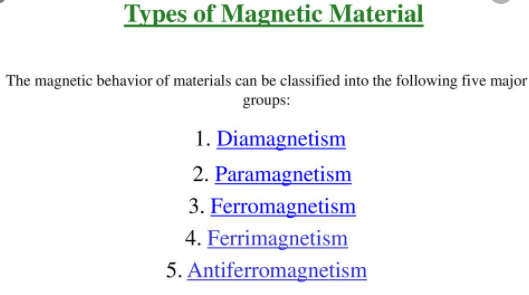
- Paramagnetic materials
- Diamagnetic materials
- Ferromagnetic materials
- Ferrimagnetism
- Antiferromagnetism
Aluminum, manganese, etc are examples of paramagnetic materials, Copper, water, alcohol are some examples of diamagnetic materials. Iron, Nickle, and cobalt are some examples of Ferromagnetic materials.
See also: Hysteresis loop
Paramagnetic substances
paramagnetic substances are those which are attracted by magnets and when placed in a magnetic field move from weaker to stronger parts of the field.
Paramagnetic materials examples
Familiar examples are:
- aluminum
- manganese
- platinum,
- crown glass
- the solution of salts of iron and oxygen
Properties of paramagnetic materials
- If a bar of paramagnetic material is suspended in between the pole pieces of an electromagnet, it sets itself parallel to the lines of force.
- When a bar of paramagnetic material is placed in a magnetic field the lines of force tend to accumulate in it.
- If a paramagnetic liquid is placed in a watch glass resting on the pole pieces of an electromagnet then it accumulates in the middle. It is because in the central region the field is the strongest. If the pole pieces are not close together the field is strongest near the poles and the liquid moves away from the center giving an almost opposite effect.
- If one end of a narrow u-tube containing a paramagnetic liquid is placed within the pole pieces of an electromagnet in such a manner that the level of the liquid is in the lie with the field, then on applying the field the level of the liquid rises. The rises in proportional to the susceptibility of the liquid.
- When a paramagnetic gas is allowed to ascend between the poles pieces of an electromagnet it spreads along the direction of the field.
Diamagnetic Substances
Diamagnetic substances are those which are repelled by magnets and when placed in a magnetic field move from the stronger to the weaker part of the field.
Diamagnetic materials examples
Familiar examples of these are:
- bismuth
- phosphorus
- antimony
- copper
- water
- alcohol
- hydrogen
Properties of Diamagnetic materials
- When a diamagnetic substance is placed in a magnetic field it sets itself at right angles to the direction of the lines of force.
- When diamagnetic material is placed within a magnetic field the lines of force tend to go away from the material.
- When a diamagnetic substance is placed in a watch glass on the pole pieces of a magnet the liquid accumulates on the sides causing a depression at the center which is the strongest part of the field. When the distance between the pole pieces is larger, the effect is reversed.
- A diamagnetic liquid in a u-tube placed in a magnetic field shows as depression.
- When a diamagnetic gas is allowed to ascend between, the poles piece of an electromagnet it spreads across the field.
Ferromagnetic Substances
Ferromagnetic substances are those which are attracted by the magnets and can also be magnetized.
Ferromagnetic materials examples
Familiar examples are:
- iron
- nickel
- cobalt and their alloys
Properties of Ferromagnetic Substances
- The ferromagnetic substance shows the properties of the paramagnetic substance to a much greater degree.
- The susceptibility has a positive value and the permeability is also very large.
- The intensity of magnetization I is proportional to the magnetizing field H for a small value.
For related topics see: Electricity and Magnetism
Handy summary of the types of magnetic materials. But please have the author proof read it. Spelling mistakes, like “megnetism” in the title/keywords. Sentences ot starting with capital letter.
Is there a difference between a magnetic filed and a magnetic field or are these terms interchangeable?
There is a confusion in your question, “difference between magnteic field and magnetic field”?
What was the original publish date? I need it for citation. Thank you.
I also need the author. Thanks again.
author name is Muhammad Shoaib
hey Joe, here’s the origional publish date 2020/01/16 at 9:56 pm
Hello,
Where does the information provided come from, who writes it and from what sources please?
I wrote my self, I researched this topic from many books, i can’t tell the exact source.
i have a magnetic rock that flakes off small pieces what is it??
Thank you for the good writeup. It in fact was a
amusement account it. Look advanced to more added agreeable
from you! By the way, how could we communicate?
Hello!
Sir can you please share same like this for Anti-ferromagntic materials.
I only can see detail on paramagnetic, diamagnetic and ferromagnetic materials.
Thanks.